Who can use Form ITR-1
A resident and ordinarily resident (ROR) taxpayer, who has a total income of up to Rs 50 lakh from salary, a house property and income from other sources, can file ITR using Form ITR-1.
However, Form ITR-1 cannot be used by a taxpayer who is either a director in a company or has invested in unlisted equity shares or in cases where tax at source (TDS) has been deducted on certain cash payments or if income tax is deferred on employee stock option plans or has agricultural income in excess of Rs.5,000.
selection of tax regime Narrate ITR 1
The alternative new tax regime was introduced from the financial year 2020-21 (AY 2022-23), and at the time of a taxpayer filing ITR It has to choose whether he/she wants to opt for such arrangement under section 115BAC of the Act if it is beneficial as compared to the regular tax regime. A taxpayer filing Form ITR-1 can change the tax regime declared to the employer at the time of deduction of tax at source on salary payment or be considered for payment of advance tax during the year.
ITR Filing Mode
A taxpayer can submit Form ITR-1 electronically. This can be done completely through online method or partly online and partly offline. In the latter mode, one needs to download the pre-filled JSON file and use the JSON utility to fill in the details, so that it can be uploaded to the Income Tax e-filing website to complete the filing process .
pre-filled information
Form ITR-1, if filed completely online, comes with some pre-filled information like personal details, salary income, dividend income, interest income etc. However, if you use the partly online and partly offline method, the individual taxpayer will be required to download the JSON utility from the new income tax portal. The pre-filled data needs to be imported into the JSON utility.
Step by step process to file Form ITR-1 in complete online mode
Go to www.incometax.gov.in and login with your credentials. Your PAN/Aadhaar number is the User ID for login.
1. Go to e-File > Income Tax Return -> Select ‘File Income Tax Return’ from the menu.
2. Select Assessment Year (AY 2022-23), Mode of Filing (Online), Applicable Status (eg Personal) and ITR Form (ITR-1) on the landing page and click on “Let’s Get Started”.


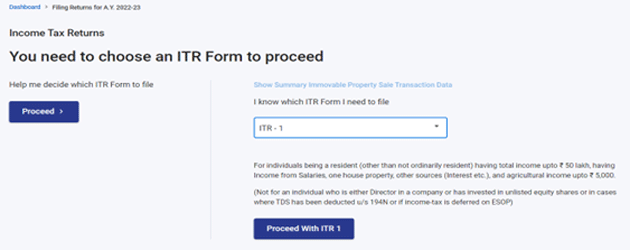
3. Select the applicable reason for filing the return of income as shown below and select ‘Continue’.
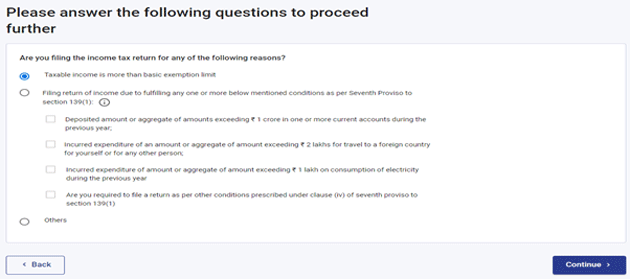
4. On the next page, the taxpayer will see 5 tabs under ‘Let’s validate your pre-filled data’. These 5 tabs are: Personal Information, Gross Total Income, Total Deductions, Tax Paid and Total Tax Liability. You have to fill and validate all these five tabs.
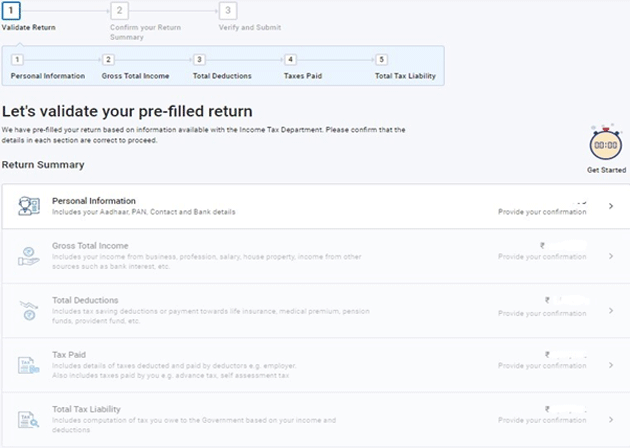
- Personal Information tab: This tab contains personal information of the taxpayer like profile (name, address, PAN, Aadhaar number, date of birth), contact details (mobile number, address and email address), nature of employment, filing section and bank details. Profile details and contact details are captured from the taxpayer’s e-filing account. Two of these contact details are editable. The taxpayer has to select the applicable nature of employment from the drop down menu.
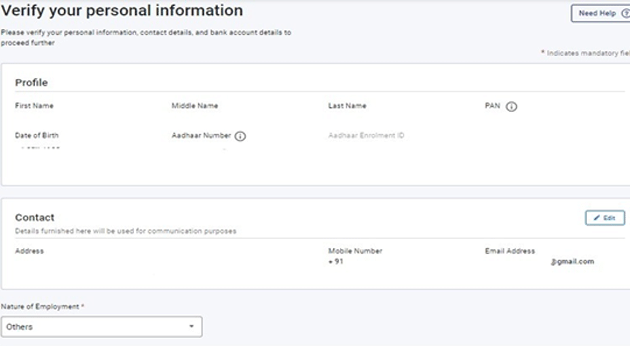
Thereafter, a taxpayer has to select the filing section under which the tax return is being filed and whether he/she wants to opt for the alternate new tax regime. Finally the taxpayer has to verify the bank accounts maintained in India during FY 21-22 and select the bank account in which he wants to receive the refund (if more than 1 bank account is reported) and Click on Confirm. As the bank details are auto-filled from the returns filed in the previous year, taxpayers can verify the same and change them accordingly.
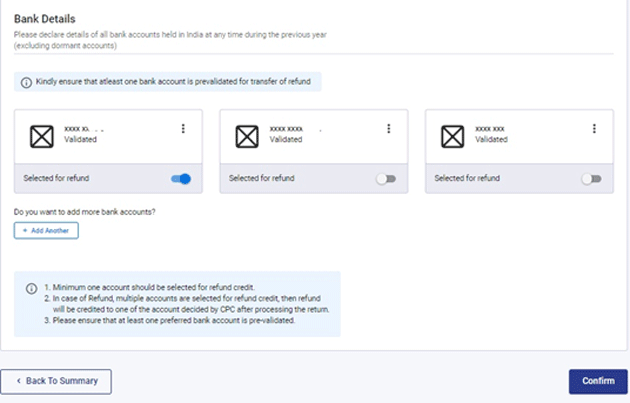
- Gross Total Income: Typically, several fields will be pre-filled under this tab. The tab will show your income from different sources (income heads) like income from salary, house property, interest etc.
– Income from salary – This data will be pre-filled from the taxpayer’s Form 16 (if the individual is salaried); Thus, the taxpayer should verify that all tax-exemptions have been claimed from the salary income applicable to him.
In this tab, the taxpayer has to select Form 16 (for example House Rent Allowance, Leave Travel Allowance etc.) in addition to Salary Exemption. If the income already entered is correct, then confirm it. If it is wrong then change it and give correct information.
– Income from house property – Rental income, interest on housing loan will be pre-filled on the basis of Form 16 (if declared to the employer). However, it is advisable to validate the pre-filled details before proceeding. If these are not already filled then you will have to fill in case of income from house property.
– Income from other sources – Here income from other sources has to be filled (checked and corrected if already filled). Examples of this type of income include:- Interest income from savings bank accounts and fixed deposits, dividend income (to be reported quarter-wise), interest earned on contributions to provident fund up to taxable limit and any other income.
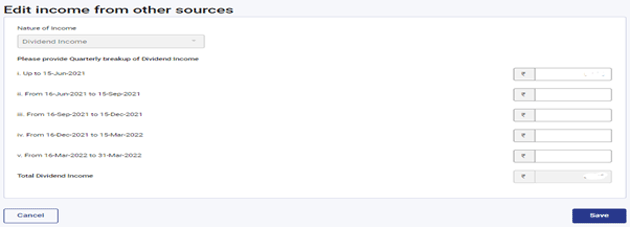
- Total deduction: Chapter VI-A Deductions claimed through employer (already forming part of your Form 16) will be auto-filled here such as deduction under section 80C for provident fund, life insurance premium etc., medical insurance premium etc. for deduction under section 80D. Also, if no such deduction was claimed through the employer, the same can be claimed directly in the return of income by providing necessary details. These details will be auto-filled from Form 16 provided you have opted for old income tax regime at the time of filing ITR along with employer. If any deduction is omitted in Form 16, you can claim it while filing ITR.
- Tax Paid: The details in this tab will be pre-filled from Form 26AS/AIS along with TDS, Advance Tax and Self-Assessment Tax (SAT), if any, paid by the taxpayer.
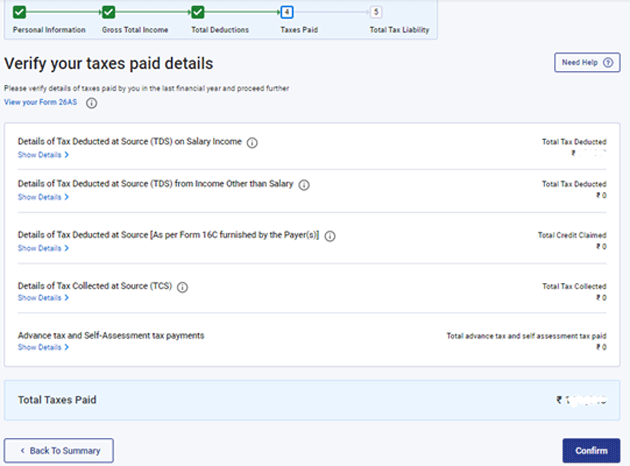
- Total Tax Liability: This tab shows the total income, taxes paid, interest payable, late fee (if any) and calculates the details of tax payable or tax payable automatically. Click on Confirm and proceed to the next page.
5. Return Summary: This is a summary of all the tabs and the taxpayer should ensure that all the tabs appear as ‘Confirmed’ and select ‘Proceed’ on the Tax Summary tab.
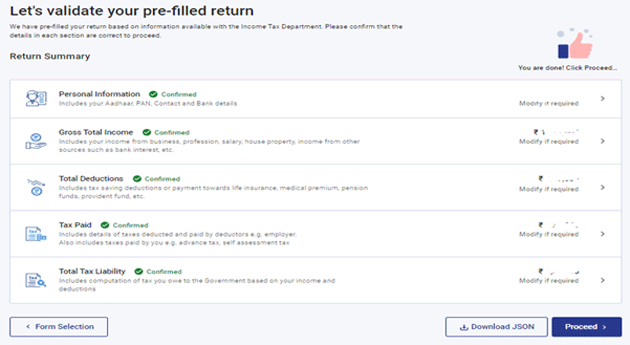
6. Tax Summary: In this tab, the taxpayer can view the Tax Summary (Nil Payable/Refund) of the tax return.
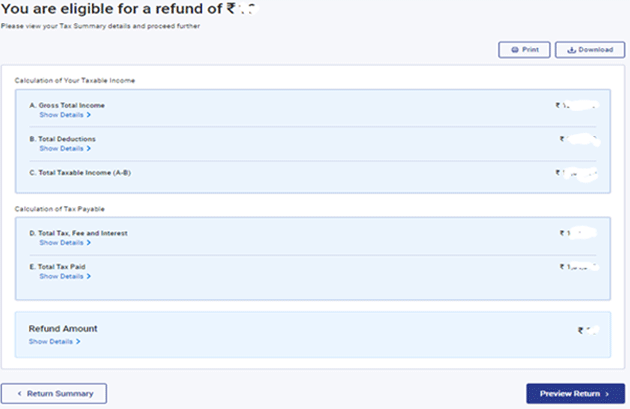
7. Announcement Tab: Once all the details are entered in the form, the taxpayer is required to fill in the requisite details in the declaration, confirming that all the details provided in the return are accurate and complete and click on ‘Preview Return’.
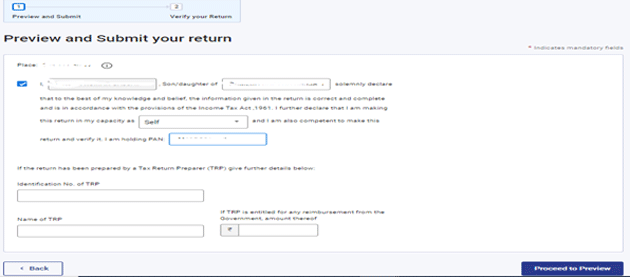
8. Preview and Submit: Taxpayer can verify personal information, income statement and taxes paid in the preview version. After verification, if the details entered are correct, he/she should click on ‘Proceed Verification’. If any error is noted, the taxpayer should click on ‘Edit’ to make necessary corrections in the respective tab/section.
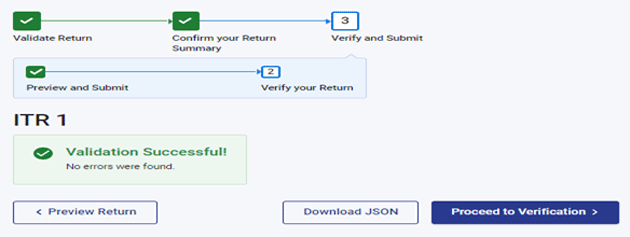
Once the return of income is filed, an SMS/e-mail intimation is sent by the tax department to the taxpayer confirming the filing. After successful submission, acknowledgment (ITR-V) is sent to the registered email id of the taxpayer. One can get it manually from the Income Tax website.
9. Verification: After successful verification, the taxpayer can proceed to verify the tax return electronically through Net Banking, Aadhaar OTP etc. or can take a printout of ITR-V (Acknowledgment) and sign the same and submit it CPC can send to Income Tax Department manually. Bengaluru within 120 days of e-filing of return of income.
Note that the signature should be in blue ink and you can send the ITRV through speed post or normal post only. ITRV cannot be sent through courier or registered post.
(The author is Partner and Head, Global Mobility Services – Tax, KPMG in India)
